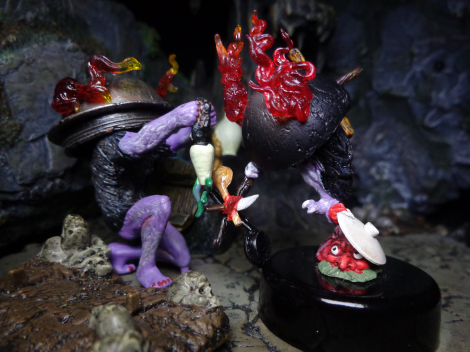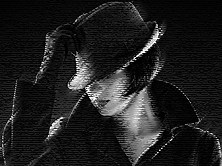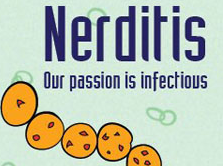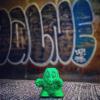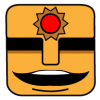"Hey, Rid," you say. "I like your toy reviews and all, but remember that one time you used toys to talk about obscure mythology? When are you going to do that again?"
How does right now sound?
Japanese religion, mythology, and folklore is different in concept than what most westerners would find familiar. Lots of folks would nod and agree and point to Buddhism, but it goes deeper than that. At its core, traditional Japanese religion combines aspects of Buddhism, Shinto, and animist traditions that predate both of those. The Japanese concept of spirits and spirituality is far removed from the way we categorize things, which is why it can be hard to discuss the Yokai.
Yokai are Japanese... spirits, creatures, ghosts, monsters, goblins, and who-knows-what. All of the above terms apply, but none of them exclusively. A Yokai might be a ghost of a person, or a ghost of an animal, or a ghost of an object, or a goblin, or a demon, or an ogre, or just a separate kind of life form that happens to coexist with people. On one end you have Oni, who are gigantic horned brutes, and Kappa, the monkey-fish who eat butts, or the Tanuki, shapeshifting raccoon dogs with gigantic testicles. On the other side there are the Tsukumogami - any object that survives for a hundred years can come alive and run around on its own. You have gigantic ghost whales, tentacle horses, people with eyes in their butts, split-faced ghosts, invisible hair-cutters, pranksters, murderers, and quiet things that hide out of sight and do nothing. Azuki-Arai washes beans and sings about eating people (but he won't. He's harmless). Otoroshi hides around temples and churches and eats the impious. Umi-Bozu is bigger than an island and sinks ships. It keeps going on! And I could probably fill up many posts talking about the Yokai.
Most modern Yokai depictions come from Shigeru Mizuki, who created the series, GeGeGe No Kitaro, which gave Yokai a massive cultural renaissance in Japan. But this post is about Kaiyodo's contributions to the genre. The figures in question were made as part of a collaboration between Kaiyodo and Furuta, actually, but Kaiyodo got the ball rolling. There are lots and lots and lots of Yokai toys out there, but this company has contributed three primary waves: Netsukes, bottle caps, and the dioramas you will see here.
A Netsuke is a type of belt clasp for a kimono. Real netsukes are incredible works of art and can fetch huge amounts of money. Kaiyodo made some Yokai toy Netsukes - each has a loop - for the fun of it, and maybe someday I'll give a post about them, too. I own most, but not all. They've got a huge variety of the smaller Yokai types, such as the Gaki (cannibal ghost) or the aforementioned Azuki-Arai.
Kaiyodo also produced bottle cap figures - well, they rest on a covering that goes over a coke bottle cap and makes it easier to twist it open. The bottle cap really isn't important. These figures are harder to come by and I have only a few - notably Ungaikyo the Mirror and Oboroguruma the Haunted Cart.
My Oboroguruma is missing his bottle cap base. But anyway, the THIRD release of figures is a bunch of little diorama figures. They are somewhat delicate, but thankfully more durable than they seem at first glance. And they are INCREDIBLE. This coffee table picture is a nice little group shot of them (along with a few Demon's Chronicle figures), since my pictures are all stylized. Note how I didn't have to stretch very hard for the environments!

Anyway, Hyakko Yako - the Night Parade of One Hundred Demons - is when all the Yokai gather and parade through the streets at night. You really don't want to run into it. And that group shot at the beginning of this article was one of my first "good" toy photos. So yeah, I've liked Yokai for a while. But let's talk about some very specific creatures, using toys as a springboard!
NURARIHYON
Nurarihyon is the most powerful Yokai of all - he's the big boss monster. The boss of bosses! All manner of demons and fiends bow at his command! So, what nefarious deeds does he perpetrate?
Nurarihyon will sneak into your house while you're away, eat your food and drink your tea, and then sneak away before you return home. Well, that's... something.
KAPPA
Wanna know how famous Kappa are? "Danger - No Swimming" signs in Japan show little cartoon Kappa grabbing swimmers. That would be like putting zombies on a biohazard warning. Kappa are amphibious creatures who kind of resemble turtles, or monkeys, or monkey-turtles. They lie in wait for their prey - usually humans - and their two favorite foods are cucumbers and anuses. Yes, really. Intestines, too, but they love munching butts more than a [JOKE REDACTED].
So, how do you defeat a Kappa? There are several ways. One is to bow in front of it - it will usually mimic the bow in respect. There is a depresion on top of each Kappa's head, which is filled with water. Spilling that water (such as by bowing too deeply) will leave a Kappa powerless and paralyzed. Another method is to offer one a cucumber. Kappa love cucumbers. He will gladly take the cucumber over his victim. And the final way - the last-ditch weakness of a Kappa - is to fart in its face. Do that, and it will flee. It should be noted that this weakness is shared by almost everybody.
TENGU
Arguably the other most-famous Yokai are the Tengu. very simply, Tengu are dogs or birds or people or demons or ghosts or gods who are good or bad or tricky or wise of violent or peaceful. Welcome to Japan.
Tengu do show up in dog, bird, and man forms, though the Karasu-Tengu, Raven Tengu, are the most famous. And among those, there are the Tengu who look like funny old men with gigantic noses - the product of shapeshifting, actually. That is reflected on this figure by giving him a long-nosed Tengu mask on his shoulder! And Tengu really can have all sorts of personalities, but usually they are dangerous. Some are tricksters and others are outright murderers, but Tegu are generlaly not to be trusted. Still others are wise and benevolent, though, so it is not a certain thing. All Tengu are powerful - they have magic and they are skilled martial artists - and it is never wise to anger one even if it is benevolent.
KITSUNE
Another extremely famous type of Yokai, the Kitsune are trickster fox spirits. You know, foxes tend to fill that role in folklore. It's an iteresting thing. Some Kitsune are guardians or faithful lovers, but most of them are impish or even cruel. As a Kitsune grows in age and power, it gains more tails - to a maximum of nine. After receiving its ninth tail, its fur also turns gold, so the one in this picture is really quite old and powerful. Those ones are usually ore on the wise or benevolent level than others - but even they might decide to assume a human form and marry somebody. You know, "Foxy Lady" and all that.
Now, those stories - the Kitsune marriage ones - tend to end tragically. Any beautiful young woman met alone at night could be a fox, and "fox-faced" is even a descriptor for a certain facial type. Some Kitsune have difficulty hiding their tails when in human form, so if you get a girl drunk and strip her down, you'll know whether she was a fox or not. You will also be a horrible predator. You jerk. In fact, that part of the subject is a little uncomfortable, so let's turn it around - Koan, a historical man known for his wisdom and knowledge, was said to be a Kitsune. Supposedly, he was found out in a bath house and had to flee. I wonder if his descendants have a different history on that.
WANYUDO
On top of reincarnation, many forms of Buddhism do believe in a Hell. It's not eternal, but sometimes evil people need more punishment than pure karma can allow. Many Japanese ghosts are based on this, like the Gaki (gluttonous people return as starving cannibal ghosts) or the Sogenbi (a wicked monk who stole oil turns into a flaming, flying head). This spirit is surprisingly similar to that last one. Wanyudo resembles a flaming cartwheel with a head in the center, and is actually a pretty popular image - one of its more off-the-wall appearances was in the Super Nintendo game, Actraiser (a game based on WESTERN fantasy). Wanyudo are the spirits of particularly evil or bloodthirsty people, who are doomed to roll around within flaming wheels, forever wrapped in torment, tirelessly dragging other evil souls into Hell. Seeing a Wanyudo is more than just bad luck, it's horrible!
One famous story involves a mother of a newborn seeing one through the window, and reacting in terror only for the Wanyudo to say, "You should stop looking at me and tend to your child!" But when she turned to the child... he was gone! When she looked back, she saw that the Wanyudo had eaten him. As I said, these things are horrible. Some Yokai are silly, but the Wanyudo are not.
As an aside, Wanyudo are fairly similar to the Irish Dullahan fairies - yes, fairies. The Headless Horseman was not an undead ghost, but a fey spirit! Dullahan's role is to ride around at night, seeking to collect the souls of those due to die. If one sees you and splashes blood on you, this is a bad omen. Eerily similar, eh?
AOBOZU
Beware the Blue Monk, AoBozu. They say he appears in rice fields, and steals children who are disobedient to their parents. Every single culture has something like this, whether it's the Bogeyman or Rawhead & Bloody Bones. If you disobey mommy and daddy, a horrible demon will rip you apart and eat you. You stupid kid.
Actually, that part of the legend is new. The first Aobozu depiction was in Toriyama Seiken's famous book (look it up), but all it had was a picture and a name. He might have been making a pun on a green/blue "inexperienced" monk. Honestly, we will never know. But AoBozu is similar to another cyclopean monk, the Hitotsume-Kozu. There are a lot of one-eyed Yokai, and a lot of monk Yokai, so it only stands to reason that there are more than a few one-eyed monk Yokai.
Oh hey, this is what the "set" looks like for one of my photos. Now you know!
NARIKAMA, NABEBOZU, & KAMAGAMI
Correction time! There are three nearly-identical Tsukumogami Yokai - Nabebozu, Kamigami, AND Narikama! The corrected material will be in bold. Narikama, pictured in the figure above, is a living kettle. He is similar to Nabebozu, who is a living pot, and Kamagami, who is a living rice pot, but entirely distinct. Narikama is "The Ringing Kettle," a Tsukumogami whose ringing sound signals good fortune.
Nabebozu translates to "The Pot-Head Monk." This does not mean what you think it means. No, really. Not at all. Stop it. Stop it right now. Stopped? Good. Nabebozu is one of the Tsukumogami - century-old heirlooms that gain a life of their own. This one is unique, though. Most Tsukumogami are simply the object with a face - the umbrella Yokai is just a one-eyed umbrella. The sandal is a sandal. And so on. But Nabebozu has an entire body! He looks like kind of a wild monk, albeit with a flaming cooking pot for a head. There isn't much info on what he does - most Tsukumogami just sort of mess around in general rather than engage in specific activities. This also looks extremely similar to Kamagami, who has a nearly-identical rice pot on its head. Kamagami wears a fur or rice husk cape (brown) and carries bamboo shoots, whereas Nabebozu carries a staff with kitchen implements tied on it (see below). This above figure carries neither, and his garb is a little shaggy, and the pot could be either dish, but I think it is close enough to the Nabebozu to count. Kamagami is a helpful little kitchen spirit who summons the gods to provide food ingredients.
So, why a monk? AoBozu is a monk, Umi-Bozu is a monk (A giant sea monster that sinks ships), and there are a whole lot more monks than just those. Why this particular imagery? Well, you have to get out of your western mindset. Yes, Buddhist and Shinto monks and priests are holy men, but they are not treated or thought of in the same way as, say, Catholic priests and monks. For something in pop culture, take the sorta-villainous monk from Princess Mononoke. He was just a guy, monk oaths or not. And there are many examples of holy men who abuse their position, or turn out just as greedy as everybody else. And yet, despite this, they are holy men, so they need to be revered. So seeing the evil monk as a spirit is almost giving form to a complaint or fear. In western terms, think of it as an evil mayor or nobleman. Or an evil priest, since we've got those, too.
TSUCHIGUMO
There are lots of spider Yokai - and this one is actually meant to be the next entry in this list, but it can also stand in got Tsuchigumo! There are really three types of Spider Yokai. Okay, there are more with spider features, but there are three spider-spider Yokai. To start with, there is the Jorogumo - i.e. the "spider whore," based on the colorful Nephila Clavata orb weaver. The Ushi-Oni will be described below. But the most generic spider is the Tsuchigumo, the "Sand Spider" or "Dirt Spider" or "Mud Spider." It is based on the Purseweb Spider, a really fat wandering spider.
Actually, Tsuchigumo started out as an ethnic slur - a name for the indigeneous tribes that occupied Japan before the modern Japanese people came in from China. They were dirt spiders. Only later did it get applied to actual dirt spiders. The Tsuchigumo of legend is a powerful and intelligent spider that can grow to be the size of a house. Some also have wolf or ox heads or tiger bodies or something else similar. And yes, like everything else, it has shapeshifting powers. One of the most famous stories (and there is a Netsuke figure commemorating the end of this) involves a samurai defeating a particularly gigantic Tsuchigumo and cutting its belly open only to find thousands of skulls and bones pour out, the remains of hundreds of meals. Try to imagine that one, arachnophobes!
USHI-ONI
The Ushi-Oni is actually an ox demon. There are ox-headed sea monsters, ox-headed flying heads (redundant?), ox-headed octopi, ox-headed squirrels... and ox-headed spiders. The most common ones are house-sized giant spiders with ox heads. And they are not friendly, not at all. Most Ushi-Oni are beastly, but some are intelligent enough to converse - and one virtuous example even donated his horns to a temple! But relaly, I am just bringing them up because I own a figure of one that was probably meant to be a Tsuchigumo.
KAWAUSO
Kawauso means "River Otter." And remember everything I said about Kitsune? It all applies here. Kawauso are what happens when a river otter lives to an advanced age - it gains shapeshifting powers. Some of them are tricksters, some benevolent, and some vicious. Sound familiar? Well, Yokai exist in categories - different kinds of Oni, or Tsukumogami, or other such creatures. And many animals follow the Kitsune pattern.
Kawauso have a few things unique to them, such as their love of fish and sake, or their penchant to mimic sounds and voices to freak people out. And rather than disguising themselves as somebody's bride (though they do that sometimes), they usually turn into small beggar children, and try to buy booze. If someone asks who they are, Kawauso panic and blow their whole cover. You know, like normal kids trying to buy booze. Another favorite activity of theirs is to snuff out lights and lanterns and leave travelers in the dark. It's all fun and games until somebody gets mugged.
NUE
Greek mythology has the Chimera, a creature with the head and body of a lion, a second head of a goat, and a serpent tail (with its own head). Iraq (Persia) has the Manticore, a creature with the body of a lion, the face of a man, the wings of an eagle, and the tail of a scorpion. The Nue is often called "The Japanese Chimera," though the only connection is its mix-and-match nature. Nue vary from creature to creature and account to account, but most often they have the body of a tiger, the face of a snow monkey, and a snake's tail - with its own snake head, too. They make bird cries as they fly in the night, concealed within dark clouds of their own making. The Nue is also one of the oldest recorded Yokai, with descriptions and legends strethcing back well over eleven hundred years ago.
The Nue are truly terrible and dangerous. When they appear, they create nightmares, spread curses, and people die. One famous story from AD 1153 involves the emperor himself falling deeply ill under both physical and spiritual ailments, as well as nightmares. One night when a storm struck the imperial palace and set the roof on fire, the samurai Minamoto realized that it was a creature, and he fired an arrow directly into the center of the storm's black cloud. This killed the Nue, who fell dead to the ground. To avoid its death curse, the inhabitants of Kyoto sent its body to the village of Ashiya, which gave it a proper burial. A nd you can actually visit the mound today, though I doubt anybody will let you dig and excavate the Nue's body. Crazy thing - this second picture (of the netsuke figure) is my most-viewed on Flickr, with well over seven thousand views. And I have no idea why.
TESSO
Tesso is the Iron Rat Demon, or the Iron Rat Monk. Like several other Yokai, he is the undead spirit of a holy man - but it's not what you think! His name was Raigo, and he is based on real historical events (up to a point. EVerything before the rats, really). Once upon a time (in the Heian era), Emperor Shirakawa desperately needed a son, and so he asked Raigo the monk to pray for him - if the emperor had a son, then he would grant any one thing Raigo asked for, no matter what. So, Raigo fervently prayed and meditated day and night, and the day came when the emperor's son was born, and he was overjoyed! So he approached Raigo and told him to name his wish, and it would be granted. Raigo wished for a monastery - his own monastery so he could train new monks and spread holiness.
However, there were three things in the world that the emperor could not control: The winds, the roll of the dice, and those evil, rebellions Enriyaku-ji monks in the mountains! The Enriyaku-ji monks are another story entirely - their history includes everything from burning down rival monasteries to working for the Yakuza - but anyway! The Enriyaku-ji hated Raigo, and did not want him to build his monastery. So they plotted, schemed, bribed, lied, and did everything in their power to stop him, and succeeded so well that not even the Emperor could build that monastery!
Raigo was understandably angry, but also powerless, and even though the emperor tried to help him as much as he could, Raigo was so enraged that he went on a hunger strike until his monastery could be built! The Enriyaku-ji were quite pleased with this, of course, and continued to block it until poor old Raigo starved to death. But because he had been so angry and vengeful when he died, and because he had been wronged so badly, he was immediately reborn as Tesso, a rat-shaped demon the size of a man, with iron fangs and claws. Tesso gathered his army of rats and invaded the Enriyaku-ji temple, wrecking the place, killing monks, and destroying all their books, scrolls, artifacts, and relics, thoroughly punishing those wicked monks for what they did. And you know, they say that Tesso still haunts the area to this day, taking out his centuries-old rage on travellers and holy men.
I guess the moral of this story is that church building fundraisers have never changed.
KYOKOTSU
Kyokotsu means "Crazy Bones." And that name fits! Kyokotsu is more of a "classic" ghost, in that it is an ethereal skeleton wrapped in a pale shroud. And it has a very simple purpose: Crazy Bones hides inside old, abandoned wells, and waits. When somebody comes up to draw water from the well, it leaps out to scare them!
That's it.
DOROTABO
Right on the heels of the skeleton ghost is a zombie! Dorotabo is "The Japanese Zombie," or so people say. Well, is it similar to our classic western zombies, whether they are Voodoo or Romero? No. Not at all. Dorotabo comes from a specific story, but there is not just one - there are many of these creatures, because the story plays out again and again.
Once upon a time, there was a peasant farmer who saved up everything he had to buy a piece of farmland. He worked his farm tirelessly for years upon years until he was able to provide for his family - it was his dream, and he lived it! And finally, at the end of his life well-spent, the old farmer left his land to his eldest son. But the son was an irresponsible wastrel who sold the far for a pittance, then gambled and drank all the money away soon after. The new owner did not care for his land as much as the old farmer had, and soon let it fall into disuse. Finally, on a moonlit night, the farmer returned to his land! His corpse rose up from the mud - made of mud, actually - with only one eye and three fingers on each hand. He looked at what had happened to his farm, and cried out with a terrifying voice, "This is my land!" And so, on many a moonlit night, you can hear the Dorotabo cry over what had happened to his dream and his legacy.
As is obvious, Dorotabo is based on a social issue. Understand, Japan has very little arable land. Most of the people live all along the coasts, with the mountainous forests of the mainland largely untouched. Farmland is rare, and hard to cultivate. Owning a farm can be seen as the Japanese version of the "American Dream." So yes, a peasant might save up his whole life for a little patch of land, and struggle to work it, but feel absolutely blessed. But then. many sons do not understand how much their fathers have sacrificed. A nd look at what happens. Dear Dad: I love you so much! I don't know if you are reading this, but I love you!
KAMAITACHI
Kamaitachi might not be as famous as the Tengu or Kappa, but try to think of all the times you have seen tornado sickle weasels in anime or video games. Like Ghosts 'N Goblins. And I think Pokemon. Maybe. Look, they're around, okay? Kamaitachi are invisible animal spirits. This kind of thing has a precedent in japanese mythology - the Sunekosuri is an invisible dog that runs through crowds, burshing against people (because surely that is the result of an invisible ghost, not a real dog).
Kamaitachi are sickle-armed weasels that live on the wind and travel in groups of three. Their favorite tactic is pretty brutal - they find people and attack! One Kamaitachi will trip you. The second will cut you up. An the third will apply a medicinal salve that instantly heals all your wounds, leaving you uninjured. I suppose that's considerate of them.
AMAKIRI
The Amakiri is not to be confused with the Kamakiri. Wow. Kamakiri is an invisible little scissor-handed creature that sneaks up on you on the day of your wedding while you are on the toilet, and cuts your hair. This is actually pretty traumatic, because it means that you have taken monk's vows. But it isn't Amakiri! Amakiri is different! Rather than cutting people's hair in the bathroom, it cuts nets!
Amakiri are essentially harmless creatures - they float aimlessly around and are actually pretty shy, hiding from humans and fierce animals. But they have one flaw, and that is cutting nets - when an Amakiri sees a net, it can't help but cut it! Snip-snip-snip! And thus, a fisherman's livelihood will be ruined. The little creature didn't mean any harm, but it happened anyway. And this is sad. Yokai are often blamed for bad things that happen - if there's a stain on your ceiling, it was because the Tenjoname licked it. If you have sleep paralysis, it's because the Kana-Shibari pinned you. If you are murdered and your body implanted with spider eggs, it's all the Jorogumo's fault. They just have to make up a supernatural explanation for everything.
NINGYO
Japan has mermaids, too! Only the Ningyo aren't quite what we are used to. They are a little less pretty than Ariel, for one thing - their fish features are far more pronounced, and their faces are actually monkeylike! Eating the flesh of a Ningyo is said to bring longevity and prosperity... but also terrible misfortune and tragedy. Some individuals might try to kill them for their meat, but it will bring doom upon the whole community. I essence, Japanese mermaids are stories about greed and lust for power, and how it might reflect on or harm those around you.
Just as western mermaids supposedly came from Manatee sightings, the Ningyo are clearly derived from Dugongs - they certainly keep a lot more of the resemblance, and modern dugongs are often treated with a level of reverence in Japan (or at least, their meat is not eaten).
NUPPEPPO
And finally, we have the Nuppeppo, a harmless little lump of flesh. Nuppeppo are mobile lumps of fatty flesh with stubby little limbs. If you look carefully, you can see how its folds barely take the shape of a face, sort of. They really stink, too, and so badly that some theorize the Nuppeppo is actually made of rotting flesh. But other people believe that if you eat one, you will gain eternal youth, so it's a little from column A, and a little from column B.
Nuppeppo are absolutely harmless and actually do not do anything - they just wander around, or sit around, or more or less exist. A lot of Yokai are like that, too - they just share this world with us, and don't hold any grudges. Personally, I think that aside from the stench, a Nuppeppo would be a great hugger.
Wow! Aren't these amazing? And there are literally thousands of Yokai! I would recommend going on Amazon and buying The Night Parade of One Hundred Demons: A Field Guide to Japanese Yokai by Matthew Meyer if you want to learn more.
By the way, this set lacked an Oni - you know, the giant devil-ogres. I know, those guys are super-famous, but you can look them up elsewhere. So hey, maybe this is a reason to bring up some other Yokai figures when possible!
Edited by Ridureyu, 30 June 2014 - 12:27 PM.
























